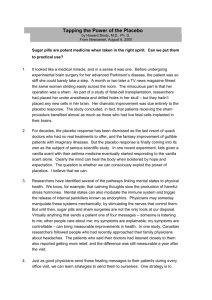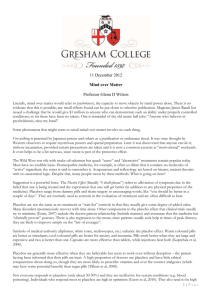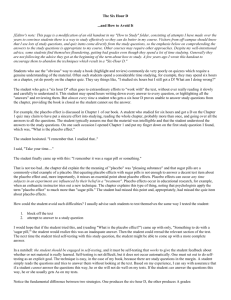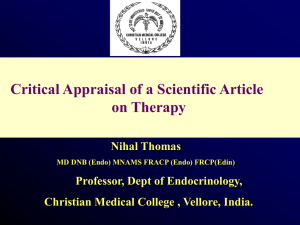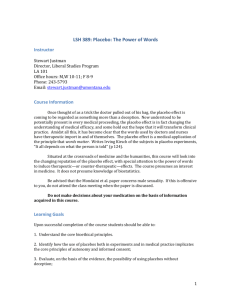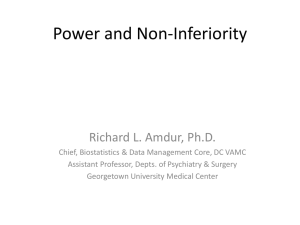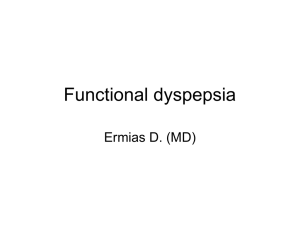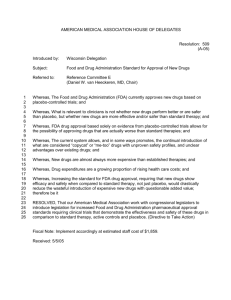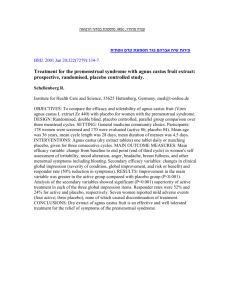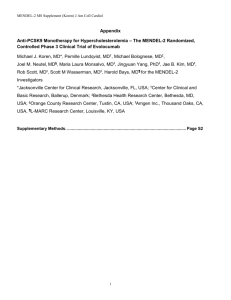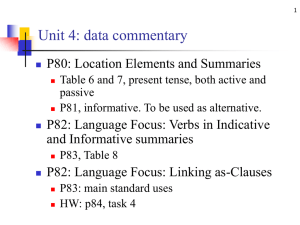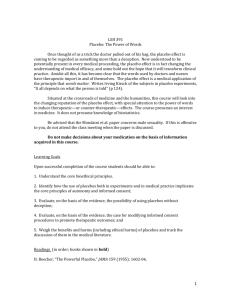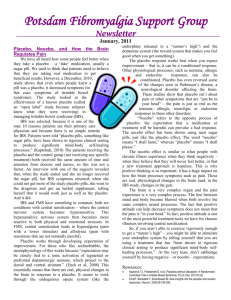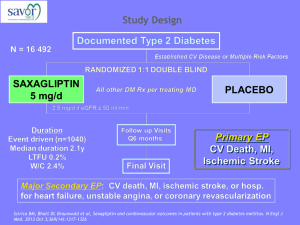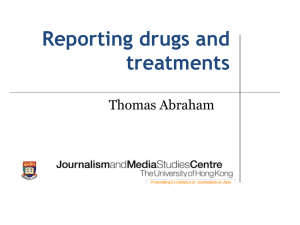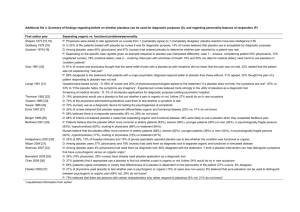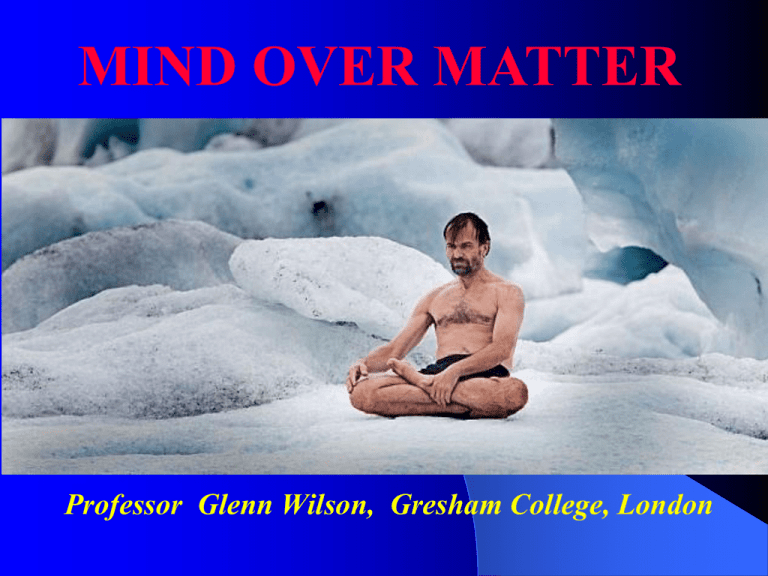
MIND OVER MATTER
Professor Glenn Wilson, Gresham College, London
PSYCHOKINESIS
Literally the capacity to influence
the physical world by mind power
alone (e.g., moving objects,
influencing dice, bending spoons).
No evidence for this that could not
be explained by publication bias.
Anyone with such powers would
make a fortune in Las Vegas.
Magician James Randi has offered
$1million to anyone who can
demonstrate it under properly
controlled conditions – so far no
takers.
FIRE-WALKING
Walking across hot embers is
performed by Japanese priests as a
purification and endurance ritual.
Often regarded as a mystical mindover-matter phenomenon but
explanation is physical – anyone can
do it given the right conditions,
without superpowers or incantations
(often done on office “motivational”
weekends).
Dangerous though: Embers must be
in late stages of burning and not
contain metal debris.
Need to walk at a steady pace, not
run (which causes the foot to plunge
too deep).
HOMEOPATHY
An “alternative” treatment
based on theory that “like
cures like” and the more
dilute the better.
Remedies often double
diluted to point that no
molecules of “active”
substance are left - they are
just water.
Despite that, many feel better
for various reasons (e.g.,
withdrawal of unpleasant
medical treatments).
THE PLACEBO EFFECT
Placebo = “I shall please”
Belief one is being treated and
expectation of improvement
will alleviate distress,
regardless of any medical
mechanisms (c.f., Mummy
“kissing it better”).
Prescribed by many doctors
but seldom blatantly. Usually
as vitamin tablets or mild,
over-the-counter analgesics
that might give some general
benefit (thus averting ethical
dilemma).
PLACEBO COMPONENTS
Many factors contribute
to effect in clinical
practice, including
“bedside manner”,
spontaneous recovery,
regression to the mean
(patients seeking
treatment when at
lowest point) and
“hello-goodbye”
effects.
Drug trials try to
minimise all but “true”
placebo effect but
usually unsuccessfully.
(Schematic pie-chart from Ernst, 2007)
PERCEIVED POTENCY
Trappings of medical
authority help (e.g., white
coat, stethoscope, diploma).
Enhanced by expense (e.g.
Bayer Aspirin beats generic
form).
Large pills better than small;
two better than one.
Colour: “hot” best for
stimulants, green for anxiety,
blue for insomnia.
Capsules more effective than
tablets; injections beat both.
SHAM SURGERY
Despite ethical issues, bogus
surgery (anaesthesia,
incisions, declaring the op a
success) sometimes as
effective as real surgery.
Studies include ops for
angina, arthritis of the knee,
spinal infusion for
osteoporosis and neuronal
implantation for Parkinson’s.
Results show staggering
placebo effects (c.f., psychic
surgeons of Indonesia).
PLACEBO RESPONDERS
Trait optimism predicts placebo response (Geers et al, 2010).
Ego-resiliency, altruism, straightforwardness and low anger/hostility
predicted placebo analgesic effect (together accounting for 25% of
variance) along with higher endorphin release and reduced cortisol
secretion (Pecina at al, 2012).
(Placebo response thus not down to stupidity, gullibility or
“weakness” of personality).
Effects, when observed in the brain, generally mimic equivalent
active medication, e.g., placebo analgesia similar to effects of
opiates (hence they are “real”).
PET scans from
Petrovic et al,
(Science, 2002).
ACUPUNCTURE
Inserting & manipulating needles
in various body areas reduce pain
and stress in some sufferers.
Difficult to find control procedures
for true double-blind evaluation
(hard not to notice you’ve been
stuck with a needle).
Differences between true and sham
procedures are small – evidence
that either exceeds placebo is
unconvincing.
Release of endorphins a better
explanation than traditional
Chinese theory of “meridians” and
“energy balance”.
NOCEBO EFFECTS
Negative (noxious) effects on health
also occur.
Voodoo curses, pointing the bone,
being bitten by a non-venomous snake,
etc. can cause death by shock or selfwill (e.g., starvation).
Chinese & Japanese regard No.4 as
unlucky. Cardiac mortality peaks on
the 4th day of each month; no such
effect in White Americans (Phillips,
2001).
Doctors have a moral dilemma about
informing a patient their condition is
terminal – some give up hope and die
more quickly.
HEADED FOR AN EARLY GRAVE?
Feelings of well-being lower mortality in
both healthy and diseased groups (Chida &
Steptoe, 2008).
People more likely to die just after a major
birthday or holiday than before.
People with +ve initials (A.C.E., V.I.P. etc)
live longer that those with –ve initials
(P.I.G., D.I.E. etc). Due to self-esteem?
(Christenfeld et al, 1999).
Catastrophes such as earthquakes and
military conflict have cardiac
consequences.
When England lost a penalty shoot-out to
Argentina in the 1998 World Cup hospital
admissions for coronaries increased 25%
(Carroll et al, 2002).
PERSONALITY & ILLNESS
Little evidence that personality is
prognostic with respect to cancer
proneness or survival, at least not
extraversion, neuroticism, or
suppression of emotion (De Vries et
al, 2012).
Hostility (one component of so-called
Type A personality) predicts coronary
proneness but effect size small and
cause and effect unclear. Irascibility
could be early sign of disease process.
Better evidence for Type D
Distressed) personality. Negative
affect (anxiety, depression, anger) is
associated with poor cardiovascular
outcomes.
IMMUNE FUNCTION
Stressful childhood + current stress
reduce ability of immune system to fight
certain diseases.
Fagundes et al (2012) found that child
neglect combined with recent life stress
led to increased vulnerability to basal cell
carcinoma. BCC is common nonmalignant skin cancer, but same may
apply to lethal cancers normally kept at
bay by the immune system (e.g.,
melanoma and ovarian cancer).
Cohen et al (2012): stressed individuals
more likely to catch a cold when exposed
to the virus (due to immune suppression).
GUIDED IMAGERY
Guided imagery is a kind of
meditation in which patient’s
thoughts are turned toward
places that are safe, happy and
relaxing. One approach is to
picture the immune system
gobbling up cancer cells and
the tumour shrinking.
Supportive in reducing stress,
anxiety & pain but little
impact on physical symptoms
and no evidence that it cures
cancer (Roffe et al, 2005).
FORGET THE PAIN
Mindfulness is an approach to
therapy derived from Buddhist
meditation. Argues that people are
happier when their thoughts are
focused on the present. (“A
wandering mind is an unhappy
mind”).
However, depends on
circumstances. In prison, or
dentist’s chair, preferable to
fantasize?
Evidence that distraction, e.g.,
performing a difficult mental task,
can be harnessed as analgesic in the
treatment of chronic pain (Sprenger
2012).
Marquis of Anglesey to Wellington at
Waterloo: “By God Sir, I’ve lost my leg.”
ELECTRIC ZEN
Knowledge of results is a major
principle in learning.
Biofeedback works on theory
that if person can observe their
own physiological processes
they are better able to exert
control over them.
Devices include EEG, ECG,
skin conductance and skin
temperature.
Clear evidence that biofeedback
is a useful adjunct to treatment
of many conditions such as
stress, hypertension, headaches,
urinary incontinence (Yucca &
Montgomery, 2008).
“CONVERSION” DISORDER
Psychogenic (hysterical)
symptoms such as blindness,
paralysis & amnesia are well
documented.
Famous case studies of Breuer &
Freud but still occur today.
May be difficult to distinguish
from deliberate malingering and
somatic causes.
Signs include: (1) precipitated by
extreme stress, (2) “belle
indifference”, (3) secondary gain
(4) retention of normal reflexes.
A HELPING HAND
Since hysteria (“wandering
womb”) is more common in
women, many psychiatrists
considered sexual frustration to
be the primary cause. Since
masturbation was considered
dangerous to health, mid-body
massage became a favoured
treatment approach - popular
with patients and doctors alike.
May have given some relief at a
time when female orgasm was
little recognised but today the
doctor would be “struck off”.
MESMERISM
Origins of hypnosis are in animal
magnetism. Mesmer initially thought
effect was physical (c.f., electrical
brain stimulation). Since it worked
especially on “hysterical” conditions,
soon recognised that the mechanism
was suggestion. Patients were
responding to his personal
magnetism and persuasion.
Freud favoured psychoanalysis
because not all patients could be
hypnotised. Amazed at how often
female patients recalled sexual
episodes with their fathers, he
attributed hysteria to child sex abuse
Anton Mesmer (1734-1815) found that
(later revised this as fantasy/desire waving magnets across hysterical patients
on part of patient).
could alleviate their symptoms.
MODERN HYPNOSIS
Suggestions of sleep/relaxation, attention
focus and compliance are used to induce a
trance state.
Suggestibility is a stable trait, not a mental
weakness. “Good” subjects engage with the
hypnotist and use imagination but seldom
behave in ways grossly out of character.
Used as therapeutic tool in dealing with
common problems such as pain, anxiety,
phobias and habit control (e.g., smoking).
Effects go beyond simple role-play (more
like total absorption in a movie) but little
evidence for super feats of strength or
memory.
False recollections may be elicited (e.g. of
past lives, alien abductions, child sex abuse).
FAITH-HEALING
Works best on conversion
symptoms. Some “miraculous”
cures have apparently
occurred, dating from Biblical
days. Still popular within
Catholicism and “charismatic”
(e.g., Pentecostal) churches.
Pilgrimages to Lourdes are
popular, where praying or
drinking the waters are
believed to heal the sick.
Miracle cures are rare (Vatican
has validated 67 out of 7000
claims) but many more might
benefit from stress reduction
and placebo.
STIGMATA
Crucifixion-style wounds have
appeared in devout Catholics,
since Francis of Assisi, 1224.
Generally poorly documented.
Some are fraud, some selfinflicted in trances during fasting.
A few may be psychogenic
purpura – purple blotches
resulting from powerful selfsuggestion (c.f., markings of alien
medical exams appearing under
hypnosis).
Appearance on palms rather than
wrists owes more to mediaeval
paintings than Roman execution
procedures.
Padre Pio, a celebrated stigmatic, canonised
in 2002, was accused of using carbolic acid
to create his wounds (Lazzatto, 2007)
HYSTERICAL CONTAGION
Mysterious illnesses strike
throughout the world. After
environmental toxins are
excluded, are put down to
hysterical anxiety.
Symptoms include fainting,
swooning, tics & paralysis.
Victims typically socially
cohesive teenage girls.
Theatrical, attention-seeking
(histrionic) individuals most
susceptible.
Social stress often implicated
(c.f., Medieval dancing plagues
& possessed nuns).
Outbreak of fainting in a Kenyan school
“THE TOWN THAT CAUGHT TOURETTES”
A recent episode in the
town of Le Roy, NY (2011)
was subject of a Ch.4
documentary.
Several teenage girls from
the same school showed
violent tics & convulsions.
No plausible organic basis
found but those affected
seemed to have difficult life
circumstances and feelings
of neglect.
Treatment with antibiotics
helped some to recover but
probably a placebo effect.
LeRoy students present symptoms on TV chat show.
THE INCREDIBLE SHRINKING MANHOOD
Not only women affected.
Outbreaks of koro (belief that
one’s genitals are shrinking)
occur sporadically in S.E. Asia,
usually in times of social stress.
Men may apply pegs or clamps to
prevent total retraction (thought
fatal).
In W. Africa, outbreaks of penis
shrinking and theft are attributed
to evil magic. Those accused are
likely to beaten to death (at least
14 penis-thieves were put to death
in Nigeria in 2001).
MIND MATTERS
Mind and body closely intertwined. Few
disorders purely physical or mental.
Peptic ulcers were once attributed to
stress alone. Then discovered that 80%
involved helicobacter pylori. However,
most people colonised by h.pylori are
asymptomatic, so not just an infectious
disease.
Warts are due to viruses but often
disappear mysteriously, so the “wartcharmers” remain in business. Seems
that stress impairs immune resources
that normally keep these disorders at
bay.
Psychosomatic effects are real, not
imaginary – their action can be observed
in the brain. Need to study interactions
between mind and body in order to
optimise treatments and benefit health.





